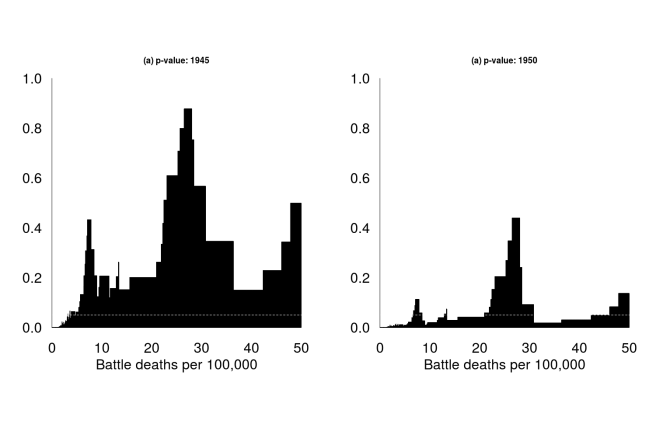I’ve just posted a new paper with Stijn van Weezel on the decline-of-war debate. This is part of an ongoing discussion which involves such people as Steven Pinker, Nassim Nicholas Taleb and Aaron Clauset.
Here is our abstract:
For the past 70 years, there has been a downward trend in the size of wars, but the idea of an enduring ‘long peace’ remains controversial. Some recent contributions suggest that observed war patterns,including the long peace, could have come from a long-standing and unchanging war-generating process, an idea rooted in Lewis F Richardson’s pioneering work on war. Aaron Clauset has tested the hypothesis that the war sizes after the Second World War are generated by the same mechanism that generated war sizes before the Second World War and fails to reject the ‘no-change’ hypothesis. In this paper, we transform the war-size data into units of battle deaths per 100,000 of world population rather than absolute battle deaths – units appropriate for investigating the probability that a random person will die in a war. This change tilts the evidence towards rejecting the no-change hypothesis. We also show that sliding the candidate break point slightly forward in time, to 1950 rather than 1945, leads us further down the path toward formal rejection of the no-change hypothesis. Next, we expand the range of wars to include not just the inter-state wars considered by Clauset (2018) but also intra-state wars. Now we do formally reject the no-change hypothesis. Finally, we show that our resultsdo not depend on the choice between two widely used war datasets.
Here is one of the key figures from the paper.

The X axis is war sizes expressed as the number of battle deaths divided by world population at the time they occurred. The Y axis for the figure on the left gives p values for tests of the hypothesis that war sizes after 1945 are generated in the same way that wars sizes before 1945 were generated. The Y axis on the right gives the same information but using 1950, rather than 1945, as the break point.
We can read off the picture on the right, for example, that wars killing more than 45 people per 100,000 of world population after 1950 have been much less common than such wars were before 1950. Indeed, the estimated probability that the pre-1950 war generation mechanism continued to operate after 1950 for wars of sizes above 45 per 100,000 is only around 0.05. So we can even formally reject a hypothesis that nothing changed after 1950 for wars of sizes 45 per 100,00 and above.
Please have a look at these slides for a more leisurely development of what I just said in the last two paragraphs. The slides explain all the key ideas in the paper. The only limitation of the slides is that they do not separate out the relative importance of each step in the argument.
There are two broad take-home points from this work:
- The evidence is fairly strong for a decline in war thesis
- We should not focus exclusively on 1945 as the only potential break point.
On point 2 I know of two separate research teams who have papers specifically on the change-point issue. I believe that neither of these papers are yet in the public domain but I expect that they will be soon.
This topic is heating up!

This analysis needs to recognise that we are not looking at stationery (in the probabilistical sense) processes. The occurrence of wars are a result of adaptation taking place in a context of socio-economic “complexity” – using that term in the sense of “complex adaptive systems” modelling. With this note of caution, to be useful, the analysis needs to look at what are thought to be causal factors, and to project the future.
While continuing technology development has enabled more “efficiently” targeted military strategies with lower human life tolls, a key factor is the post-WWII growth of globalisation and with that, international trade and law, capital mobility and access to information that has driven higher living standards. If, as some think, these trends are in jeopardy, how would it influence a return to greater militarism.
LikeLike
Hi. Thanks for your comment.
I agree that it is crucial to look not just at the numbers but also at the qualitative and historical factors that actually cause wars and war sizes. We don’t actually do this in our paper but a full analysis has to.
LikeLike
I think there’s a lot more to it when you include the rise in communication and information systems. Where in the past large groups of people could be isolated and killed, internet and (mobile) phones aid people in avoiding the brunt of conflicts and assist in humanitarian aid to relief them.
Take for example the Balkan war in the 1990’s. Without modern communication the ethnic cleansing would probably have succeeded or at least be much worse.
Also, I’d like the graphs to be split out in combatants and non-combatants.
LikeLike
Hi. Thanks for these thoughtful comments.
So it seems that there is a steady stream of wars starting up but it also seems that there is a tendency for the killing to stop at lower levels, at least in population adjusted terms, than used to be the case. You provide a plausible mechanism that might explain this trend, at least in part.
On the graphs, sadly the data doesn’t provide the required information and it’s unlikely that we will every be able to fill in this historical information systematically and credibly.
LikeLike